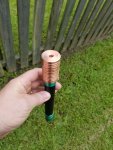Buffo
0
- Joined
- Jan 27, 2008
- Messages
- 53
- Points
- 18
So, yeah, I know it's irresponsible (some would say reckless) to build a hand-held laser with this sort of output power, but it was something I've always wanted to try.
Huge thanks to Rich (Lifetime17) for his assistance with the custom-machined host. He had to do a good bit of extra machining to accommodate the large 25 mm copper heat sink module that I selected for this build. If anyone is considering a build like this, speak with Rich first! His work is first-rate, and his prices are very reasonable. The host is ~ 25 mm long and holds two 18650 Li batteries in series.
I went with the NUMB44 (V2) diode for this project. I got it from Jordan at DTR laser. (Another great guy to deal with! Fast shipping, and never any problems.) I'll freely admit that I sort of cheated here in that I ordered an all-up module with the diode, driver, and G2 lens already installed and the current pre-set for 5 amps. I've worked with bare diodes before, but for this project I was in a bit of a rush and wanted everything to be plug-and-play when it arrived.
I selected the 25 mm copper heat sink for the diode, although if I had it to do over again I think I would have gone with the smaller 20 mm module. In my opinion both are overkill for a handheld, but the 25 mm unit is really big and it forced Rich to do some extra machining to make it fit in the host I selected. For sure I won't ever have any overheating issues though!
I'm very pleased with the results of the build. Of course, because there's no secondary correction optics, the fast axis of the beam rapidly spreads to a line after a few meters. But up close (less than 25 cm) the beam is pretty much lethal even before you try to focus it - anything remotely combustible will immediately begin to char at close range. This is one of those projects where at the end you sort of chuckle nervously to yourself as you wonder if maybe, just maybe, this wasn't such a good idea after all.
Now that I've gotten the itch out of my system, I don't think I'll build any more handhelds. Truthfully this thing is impractical as hell - both because of the extreme danger due to the output power and because at anything beyond close range the beam quality rapidly degrades due to the lack of fast-axis correction. But it's still fun to fire it up and marvel at the fact that it's making north of 7 watts and it's a handheld! Part of my brain is still scolding me for being so irresponsible, but another part is cheering about the memory of smoke rising from one of the fence boards when I first tested it.

Here's a video of the brief test that followed the picture above:
Adam
Huge thanks to Rich (Lifetime17) for his assistance with the custom-machined host. He had to do a good bit of extra machining to accommodate the large 25 mm copper heat sink module that I selected for this build. If anyone is considering a build like this, speak with Rich first! His work is first-rate, and his prices are very reasonable. The host is ~ 25 mm long and holds two 18650 Li batteries in series.
I went with the NUMB44 (V2) diode for this project. I got it from Jordan at DTR laser. (Another great guy to deal with! Fast shipping, and never any problems.) I'll freely admit that I sort of cheated here in that I ordered an all-up module with the diode, driver, and G2 lens already installed and the current pre-set for 5 amps. I've worked with bare diodes before, but for this project I was in a bit of a rush and wanted everything to be plug-and-play when it arrived.
I selected the 25 mm copper heat sink for the diode, although if I had it to do over again I think I would have gone with the smaller 20 mm module. In my opinion both are overkill for a handheld, but the 25 mm unit is really big and it forced Rich to do some extra machining to make it fit in the host I selected. For sure I won't ever have any overheating issues though!
I'm very pleased with the results of the build. Of course, because there's no secondary correction optics, the fast axis of the beam rapidly spreads to a line after a few meters. But up close (less than 25 cm) the beam is pretty much lethal even before you try to focus it - anything remotely combustible will immediately begin to char at close range. This is one of those projects where at the end you sort of chuckle nervously to yourself as you wonder if maybe, just maybe, this wasn't such a good idea after all.
Now that I've gotten the itch out of my system, I don't think I'll build any more handhelds. Truthfully this thing is impractical as hell - both because of the extreme danger due to the output power and because at anything beyond close range the beam quality rapidly degrades due to the lack of fast-axis correction. But it's still fun to fire it up and marvel at the fact that it's making north of 7 watts and it's a handheld! Part of my brain is still scolding me for being so irresponsible, but another part is cheering about the memory of smoke rising from one of the fence boards when I first tested it.

Here's a video of the brief test that followed the picture above:
Adam



